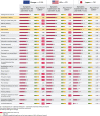Global cross-sectional survey of women with vasomotor symptoms associated with menopause: prevalence and quality of life burden
- PMID: 34033602
- PMCID: PMC8746897
- DOI: 10.1097/GME.0000000000001793
Global cross-sectional survey of women with vasomotor symptoms associated with menopause: prevalence and quality of life burden
Erratum in
-
ERRATUM.Menopause. 2022 Jun 1;29(6):759. doi: 10.1097/GME.0000000000001996. Menopause. 2022. PMID: 35674657 No abstract available.
Abstract
Objective: To determine prevalence and health-related quality of life (HRQOL) of moderate-to-severe vasomotor symptoms (VMS) in postmenopausal women in Europe, the US, and Japan, and among subgroups of women not taking hormone therapy (HT).
Methods: Screening surveys were sent to a random sample of women aged 40 to 65 years; full questionnaires followed to those who completed them and met inclusion criteria. Women with successfully treated VMS, breast cancer, or on HT for medical conditions were excluded. The Menopause-Specific QOL (MENQOL) and Work Productivity and Activity Impairment (WPAI) questionnaires were included in the questionnaire.
Results: Of 25,161 women completing the screening survey, 11,771 were postmenopausal and 3,460 met inclusion criteria and completed the full questionnaire. Prevalence of moderate-to-severe VMS was 40%, 34%, and 16% in Europe, the US, and Japan, respectively. A large proportion were HT averse, albeit eligible (Europe 56%, US 54%, Japan 79%). In total, 12%, 9%, and 8% in Europe, the US, and Japan, respectively, were HT-contraindicated. A high proportion were HT-cautious (Europe 70%, US 69%, Japan 52%). Most common menopausal symptoms reported in the MENQOL were feeling tired or worn out (Europe/US 74%, Japan 75%), aching in muscles and joints (Europe 69%, US 68%, Japan 61%), difficulty sleeping (Europe 69%, US 66%, Japan 60%), and hot flashes (Europe 67%, US 68%, Japan 62%). Overall, the most bothersome symptom was weight gain. As measured by the WPAI, hot flashes and night sweats had a greater impact on daily activities than on working activities.
Conclusions: A high proportion of women experienced moderate-to-severe VMS, with associated symptoms impacting QOL.
Copyright © 2021 by The North American Menopause Society.
Conflict of interest statement
Financial disclosure/conflicts of interest: R.E.N. is a lecturer and consultant for Bayer, Exceltis, and Theramex; a researcher for Novo Nordisk; a researcher and consultant for Fidia; a lecturer for MSD and Pfizer; a consultant for Astellas and Palatin; and a researcher and lecturer for Shionogi. R.K. is a consultant and researcher for Astellas, Allergan, Estetra, Therapeutics MD, and a researcher for Bayer and Mithra. C.R. and E.G. have no disclosures to report. B.S. is a former employee of Astellas. E.S. and N.S. are employees of Astellas.
Figures


Comment in
-
Prevalence and impact on quality of life of vasomotor symptoms.Menopause. 2021 May 17;28(8):850-851. doi: 10.1097/GME.0000000000001803. Menopause. 2021. PMID: 34010936 No abstract available.
References
-
- Food and Drug Administration. Guidance for industry: estrogen and estrogen/progestin drug products to treat vasomotor symptoms and vulvar and vaginal atrophy symptoms — recommendations for clinical evaluation. Available at: https://www.fda.gov/media/71359/download. Accessed April 22, 2021.
Publication types
MeSH terms
LinkOut - more resources
Full Text Sources
Other Literature Sources
Medical
Research Materials
Miscellaneous

